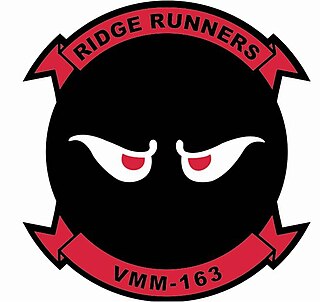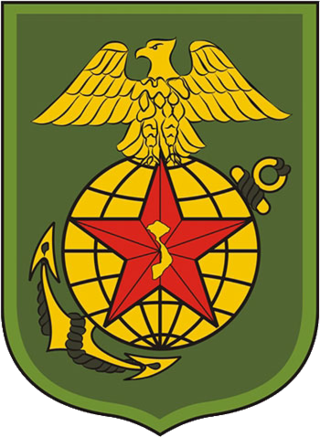
The 3rd Marine Division is a division of the United States Marine Corps based at Camp Courtney, Marine Corps Base Camp Smedley D. Butler in Okinawa, Japan. It is one of three active duty infantry divisions in the Marine Corps and together with the 1st Marine Aircraft Wing (1stMAW) and the 3rd Marine Logistics Group forms the III Marine Expeditionary Force. The division was first formed during World War II and saw four years of continuous combat in the Vietnam War. Today, elements of the 3rd Marine Division are continuously forward deployed and forward postured to carry out the US Government's mission of a Free and Open Indo-Pacific in conjunction with its sister services.

Marine Aircraft Group 16 is a United States Marine Corps aviation unit based at Marine Corps Air Station Miramar that is currently composed of four V-22 Osprey squadrons, four CH-53 Super Stallion squadrons, one Personnel Support Detachment, and an aviation logistics squadron. The group falls under the command of the 3rd Marine Aircraft Wing and the I Marine Expeditionary Force.

Marine Medium Tiltrotor Squadron 163 (VMM-163) is a United States Marine Corps helicopter squadron consisting of MV-22 Osprey transport tiltrotors. The squadron, known as "Evil Eyes", is based at Marine Corps Air Station Miramar, California and falls under the command of Marine Aircraft Group 16 (MAG-16) and the 3rd Marine Aircraft Wing.

The 27th Marine Regiment is an inactivated infantry regiment of the United States Marine Corps. They fought during the battle of Iwo Jima in World War II and again for a short time during the Vietnam War.

The Republic of Vietnam Marine Division was part of the armed forces of South Vietnam. It was established by Ngo Dinh Diem in 1954 when he was Prime Minister of the State of Vietnam, which became the Republic of Vietnam in 1955. The longest-serving commander was Lieutenant General Le Nguyen Khang. In 1969, the VNMC had a strength of 9,300, 15,000 by 1973, and 20,000 by 1975.

3d Force Reconnaissance Company is a force reconnaissance unit of the United States Marine Corps Reserve. The company is located in Mobile, Alabama.

The 1st Division of the Army of the Republic of Vietnam (ARVN)—the army of the nation state of South Vietnam that existed from 1955 to 1975—was part of the I Corps that oversaw the northernmost region of South Vietnam, the centre of Vietnam.

Operation Taylor Common was a search and destroy operation conducted by Task Force Yankee, a task force of the 1st Marine Division supported by the Army of the Republic of Vietnam (ARVN), southwest of Hội An from 6 December 1968 to 8 March 1969.
Operation Prairie IV was an operation conducted by the United States Marine Corps in the area around Con Thien, South Vietnam known as Leatherneck Square from 20 April until 17 May 1967. During the course of the fighting Marine casualties were 164 killed 1,240 wounded while claiming 505 People's Army of Vietnam (PAVN) killed and 9 captured.

The Hue–Da Nang Campaign was a series of military actions conducted by the People's Army of Vietnam (PAVN) against the Army of the Republic of Vietnam (ARVN) during the Vietnam War, also known in Vietnam as the American War. The campaign was centred on the cities of Huế and Da Nang, with secondary fronts in the provinces of Quảng Trị and Quảng Ngãi. The campaign began on March 5 and concluded on April 2, 1975.
The 304 Division is an infantry division of the People's Army of Vietnam (PAVN). It was established in January 1950 at Thanh Hoa.
The 325th Infantry Division is a division of the People's Army of Vietnam (PAVN), first formed in March 1951 from independent units in Thừa Thiên, it is likely that it only became fully operational in mid-1952. It was one of the 6 original "Iron and Steel" Divisions of the Viet Minh.

The 9th Marine Expeditionary Brigade was a United States Marine Corps unit.
Hill 724 is a former U.S. Marine Corps (USMC) base near the summit of the Hải Vân Pass north of Da Nang in central Vietnam.
The 1st Battalion, 26th Marines (1/26) is an inactive infantry battalion of the United States Marine Corps. They were part of the 26th Marine Regiment and 5th Marine Division and fought during the Battle of Iwo Jima in World War II. They were activated again for the Vietnam War but were deactivated after the war and remain inactive today.
The 3rd Battalion, 26th Marines (3/26) is an inactive infantry battalion of the United States Marine Corps. They were part of the 26th Marine Regiment and 5th Marine Division and fought during the Battle of Iwo Jima in World War II. They were activated again for the Vietnam War but were deactivated after the war and remain inactive today.

Foster Carr LaHue was a lieutenant general in the United States Marine Corps. He saw combat in World War II, the Korean War and the Vietnam War. During the Vietnam War, he commanded Task Force X-Ray which was involved in the heaviest fighting at the Battle of Huế.
The Battle of Phú Lộc took place from 28 August to 10 December 1974 when North Vietnamese forces captured a series of hills and installed artillery that closed Phu Bai Air Base and interdicted Highway 1. The hills were recaptured by the South Vietnamese in costly fighting that depleted its reserve forces.
Operation Houston was a security operation in the Vietnam War conducted by the United States Marine Corps’ Task Force X-Ray to reopen and secure Route 1 between Da Nang and Phu Bai Combat Base that took place from 26 February to 12 September 1968.

The attacks on Da Nang, were a series of attacks in the Tet Offensive launched by the North Vietnamese People’s Army of Vietnam (PAVN) and the Viet Cong (VC) during the Vietnam War. The attacks were repulsed by combined United States Marine Corps (USMC), United States Army, Army of the Republic of Vietnam (ARVN) and Republic of Korea Marine Corps (ROKMC) forces with the PAVN/VC suffering heavy losses.













